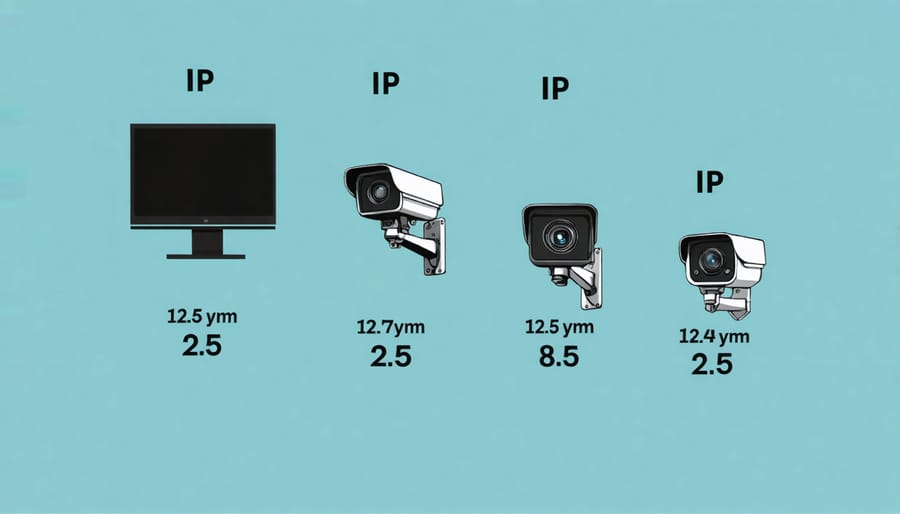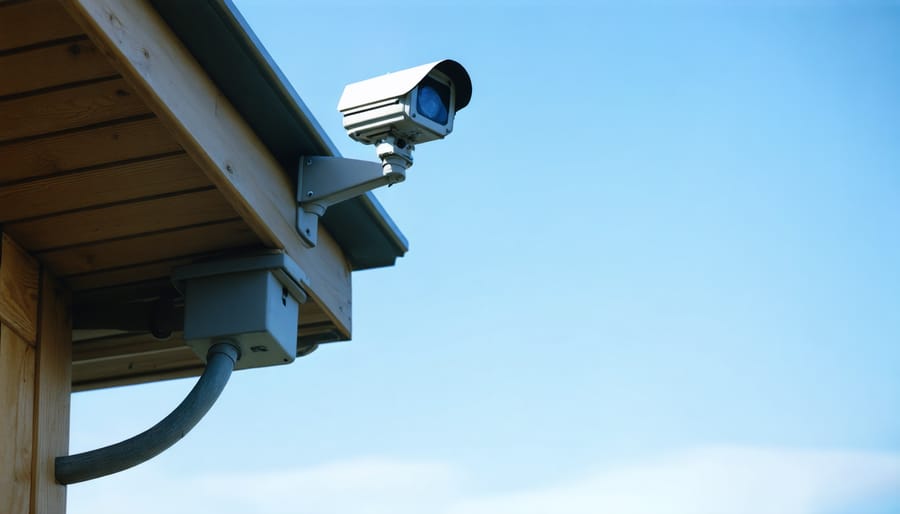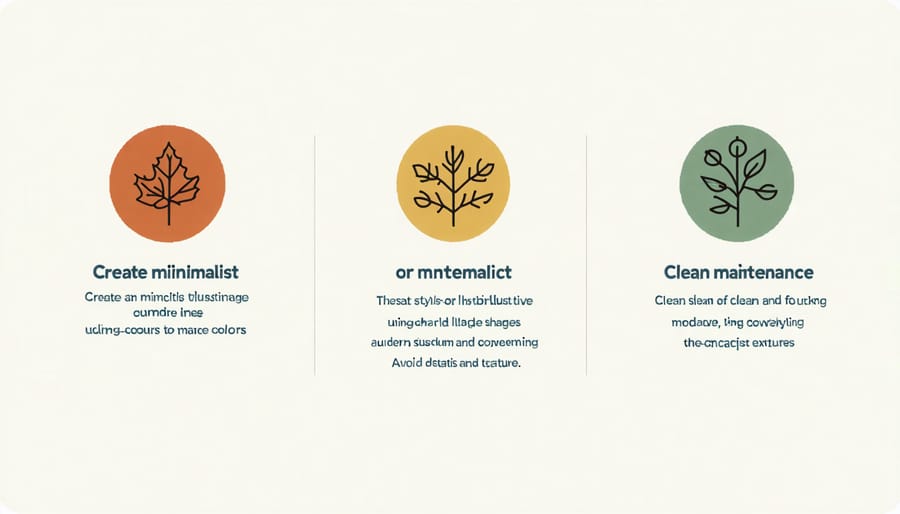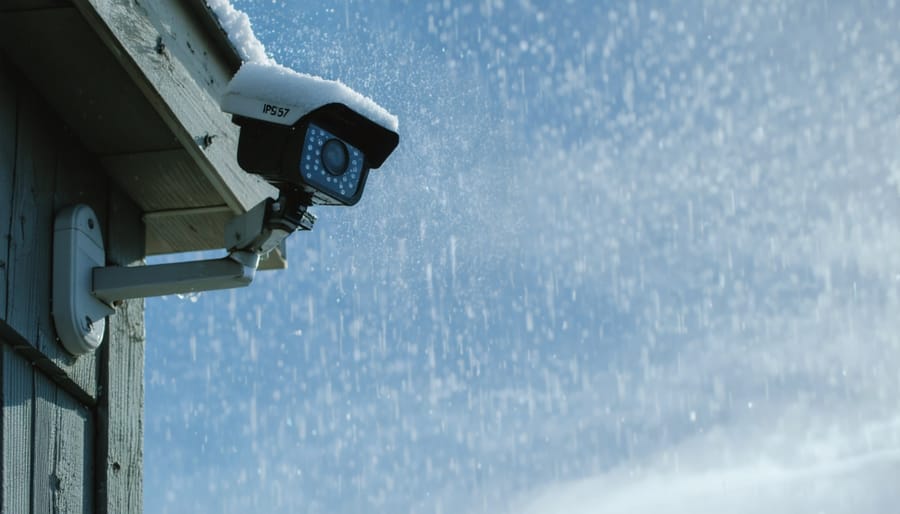Protect your valuable outdoor assets with weather-resistant security cameras that withstand nature’s harshest elements. From scorching sun to freezing rain, these rugged surveillance devices serve as vigilant guardians, forming an essential component of modern smart security systems. Built with specialized IP67-rated enclosures, quality outdoor cameras deliver crystal-clear footage while resisting moisture, dust, and temperature extremes. Whether safeguarding a backyard shed or monitoring your home’s perimeter, weather-resistant cameras offer year-round protection without requiring constant maintenance or replacement. Recent advances in weatherproofing technology have made these cameras more reliable and affordable than ever, providing homeowners with peace of mind through every season and storm.
Key Features of Weather-Resistant Security Cameras
IP Ratings Explained
When shopping for outdoor security cameras, you’ll often encounter “IP ratings” – but what do these mysterious numbers mean? IP (Ingress Protection) ratings tell you exactly how well your camera can stand up to dust and water. The rating consists of two numbers: the first indicates dust protection (0-6), and the second shows water resistance (0-8).
For outdoor cameras, look for ratings like IP65, IP66, or IP67. The “6” means the camera is completely dustproof, while the second number indicates water protection levels. An IP65 camera can handle water jets from any direction, IP66 can withstand powerful water jets, and IP67 can actually survive being submerged in water up to 1 meter deep for 30 minutes.
For most home security needs, an IP65 or IP66 rating is perfectly sufficient. These cameras will easily handle rain, snow, and dusty conditions. Just remember that even the best IP rating won’t protect against physical damage or extreme temperatures, so proper installation and maintenance are still essential.

Temperature Tolerance
Operating temperature range is a crucial factor when choosing a weather-resistant security camera for your outdoor space. Most quality outdoor cameras are designed to function reliably between -4°F and 122°F (-20°C to 50°C), which covers typical weather conditions in most regions. However, if you live in an area with extreme temperatures, you’ll want to pay special attention to these specifications.
In freezing conditions, cameras need robust internal components and proper housing to prevent condensation and protect the lens from frost. During hot summer days, the camera must resist overheating, which could affect video quality or cause the device to shut down temporarily. Look for models with built-in temperature regulation features like internal heaters for cold climates or cooling systems for hot weather.
To ensure optimal performance, consider installing your camera in a location that offers some natural protection from direct sunlight and extreme weather while maintaining a clear view of your monitoring area. Some homeowners choose to add protective housing or covers for additional temperature regulation, especially in regions with challenging climate conditions.
Smart Installation Tips for Maximum Weather Protection
Optimal Placement Locations
Strategic placement of your weather-resistant security camera is crucial for both optimal surveillance and protection from the elements. The best location is typically under the eaves or soffit of your home, where the camera benefits from natural shelter against rain, snow, and direct sunlight. This positioning also helps prevent water from running directly over the camera lens during heavy rainfall.
For comprehensive coverage, consider mounting cameras at the corners of your property, approximately 8-10 feet high. This height keeps cameras out of reach from potential tamperers while providing a wide viewing angle. When installing near entry points, position cameras to face slightly downward at a 30-45 degree angle for the clearest view of visitors’ faces.
Avoid placing cameras where they’ll be directly exposed to morning or evening sun, as this can create glare and affect image quality. Instead, orient cameras facing north when possible to minimize sun exposure. For areas without natural overhead protection, consider installing a small weather hood or awning above the camera for added shelter.
Remember to position cameras away from sprinkler systems and ensure they’re not blocked by growing vegetation or seasonal decorations. If mounting on a fence or post, choose a sturdy location that won’t sway in strong winds, as movement can trigger false alerts and reduce video quality.

Additional Weather Guards
While weather-resistant cameras offer built-in protection, adding extra protective measures can significantly extend their lifespan and enhance performance. Camera housings serve as your first line of defense, functioning like a protective shell that shields your security equipment from harsh elements. When selecting housings, look for options with IP66 ratings or higher, which provide excellent weather protection solutions against both dust and water.
Consider installing protective hoods or sunshields that extend slightly over the camera lens. These accessories prevent direct rainfall and reduce glare from sunlight, ensuring clearer footage and protecting sensitive components. For areas with extreme temperatures, look for housings with built-in heating and cooling systems to maintain optimal operating conditions.
Camera covers made from durable materials like polycarbonate or aluminum offer additional protection without compromising image quality. Some covers feature anti-fog and anti-condensation properties, particularly useful in humid environments. Quick-release mechanisms make maintenance easier while maintaining a weather-tight seal.
Don’t overlook cable protection – use weather-resistant conduit or cable housing to protect power and data connections. This prevents moisture from traveling along cables and entering the camera housing. Installing drip loops in your cables creates a natural water barrier, directing moisture away from connection points.
Maintenance Tips for Long-Term Protection

Seasonal Check-ups
Regular seasonal inspections are crucial for maintaining your weather-resistant security camera’s performance. In spring, check for any winter damage and clean off pollen or debris that may have accumulated. Pay special attention to the camera housing seals and ensure they haven’t been compromised by freeze-thaw cycles. Just as you focus on weatherproofing your shed, your camera needs similar attention.
Summer maintenance should include checking that heat vents aren’t blocked and ensuring sun exposure hasn’t degraded any protective covers. Clean the lens more frequently during this season, as dust and insects tend to be more prevalent.
During fall, clear away any fallen leaves that might obstruct the camera’s view or trap moisture. Check that all mounting brackets are secure before winter storms arrive. Test the night vision functionality as daylight hours decrease.
Winter requires the most vigilance – regularly remove snow and ice buildup from the camera housing and ensure condensation isn’t forming inside the unit. Verify that all weatherproof seals remain intact and flexible, not brittle from cold temperatures.
Quick Fixes for Common Issues
When your weather-resistant camera encounters issues, try these simple fixes before calling technical support. If your camera shows condensation inside, place silica gel packets near the camera housing or use a hairdryer on low heat from a safe distance to remove moisture. For cameras with poor nighttime visibility, clean the IR sensors with a soft, dry cloth and ensure no objects are blocking the sensors.
If your camera stops working after heavy rain, check that all weatherproof seals are intact and properly closed. Tighten any loose gaskets and apply weatherproof tape around connection points if needed. For cameras showing interference during storms, check that all cables are properly grounded and consider adding a surge protector.
When video quality decreases, first clean the camera lens with a microfiber cloth. If image quality remains poor, adjust the camera’s position to reduce direct sunlight exposure. For cameras that frequently disconnect, ensure all cable connections are secure and protected from moisture. Consider adding a weatherproof junction box for extra protection of electrical connections.
Remember to regularly inspect mounting brackets, as they can loosen over time due to wind and weather exposure. Tighten any loose screws and apply rust-resistant coating if needed.
Power and Connectivity in Harsh Weather
Maintaining reliable power and connectivity during harsh weather is crucial for your security camera’s performance. To ensure uninterrupted surveillance, consider installing a battery backup system or an uninterruptible power supply (UPS). These devices provide temporary power during outages, giving you peace of mind even during storms.
For continuous operation, solar-powered security cameras are becoming increasingly popular. When paired with a high-capacity battery, these systems can operate independently of the main power grid. Just ensure the solar panel is installed in a location that receives adequate sunlight and is kept clear of snow and debris.
Internet connectivity can be equally challenging during bad weather. A dual-band WiFi system offers better reliability, as it can switch between 2.4GHz and 5GHz frequencies depending on weather conditions. For areas with weak WiFi signals, consider installing a WiFi extender or mesh network system to maintain a stable connection to your camera.
Some weather-resistant cameras now come with cellular backup capabilities. While this typically requires a separate data plan, it provides an excellent failsafe when your home internet goes down. Look for cameras that automatically switch to cellular data during WiFi outages.
Cable management is also essential for weather resistance. Use weatherproof cable housing and ensure all connections are properly sealed with waterproof caps or boxes. Route cables through protected areas when possible, and create drip loops to prevent water from running down the cables into your camera or power source.
For ultimate reliability, consider hardwired PoE (Power over Ethernet) cameras, which receive both power and internet through a single, weather-protected cable, minimizing potential points of failure during severe weather.
Investing in a weather-resistant security camera is essential for maintaining effective surveillance around your property throughout the year. By choosing a camera with robust weather protection features, you ensure reliable monitoring regardless of rain, snow, or extreme temperatures. Remember to look for key features like high IP ratings, quality housing materials, and proper mounting options to maximize your camera’s longevity. Regular maintenance, including cleaning and seasonal checks, will help extend your camera’s lifespan and maintain optimal performance. While the initial investment in a weather-resistant camera might be higher, the long-term benefits of durability, consistent functionality, and peace of mind make it a worthwhile choice for any homeowner serious about security. With proper selection and care, your weather-resistant security camera will serve as a reliable guardian of your property for years to come.





Leave a Reply